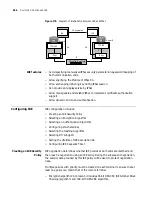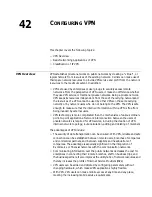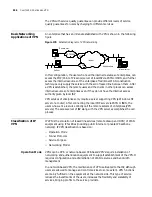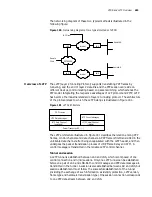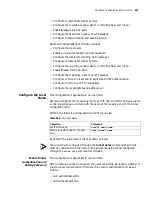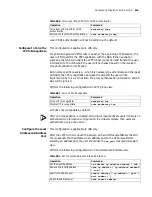
602
C
HAPTER
43: C
ONFIGURING
L2TP
Figure 179
Networking diagram of typical VPDN application
In this figure, LAC stands for L2TP Access Concentrator, which is a switch network
device with a PPP end system and L2TP client-side processing ability. Usually, LAC is
a NAS, which provides access service for users through PSTN/ISDN. LNS stands for
L2TP Network Server, which is the device with a PPP end system and L2TP
server-side processing ability.
LAC resides between the LNS and the remote system (remote users and remote
branches) and is responsible for transmitting packets between them. It
encapsulates the packets received from the remote system according to L2TP and
sends them to the LNS, then de-encapsulates the packets from the LNS and sends
them to the remote system. A local connection or PPP link can be used between
the LAC and the remote system, but in a VPDN application, the PPP link is often
adopted. Being an end of the L2TP tunnel, LNS is the peer device of LAC and is the
logical terminating end of the PPP sessions transmitted by the LAC through the
tunnel.
Methods of
Implementing VPDN
There are two methods to implement VPDN:
■
NAS-originated VPN: NAS first establishes a tunnel with VPDN gateway using
tunneling protocol, conveying the PPP connection to the gateways of
enterprises. The current available protocols are L2F and L2TP.The advantage of
the method is its transparency to users. After logging in once, the users can
access the Intranet, which authenticates the users and distributes the internal
addresses for users, avoiding consuming public addresses. The accounting of
dial-up users can be implemented by the AAA at the LNS or LAC side. Users
can access the network through various platforms. With the method, NAS
should support VPDN protocol and the authentication system should support
VPDN attributes. The gateway is usually a router or a VPN private gateway.
■
Client-originated VPN: The client at the user end establishes a tunnel with the
VPDN gateway. The client first calls and connects to the Internet, then
establishes a tunnel connection with the enterprise gateway through special
software for client (such as L2TP supported by Windows2000 platform). The
advantage of the method is that there is no mode or geographical limit on
accessing the Internet for users, independent of the ISP. The accounting of
dial-up users can only be implemented through the AAA at the LNS side. The
disadvantage of this method is that the users may be required to install special
software.
PC
PSTN/ISDN
Remote users
Access server
Remote users
Internal server
Internet backbone
network
L2TP channel
LAC
LNS
Router
Summary of Contents for 3036
Page 1: ...http www 3com com 3Com Router Configuration Guide Published March 2004 Part No 10014299 ...
Page 4: ...VPN 615 RELIABILITY 665 QOS 681 DIAL UP 721 ...
Page 6: ...2 ABOUT THIS GUIDE ...
Page 7: ...I GETTING STARTED Chapter 1 3Com Router Introduction Chapter 2 3Com Router User Interface ...
Page 8: ...4 ...
Page 16: ...12 CHAPTER 1 3COM ROUTER INTRODUCTION ...
Page 34: ...30 ...
Page 60: ...56 CHAPTER 3 SYSTEM MANAGEMENT ...
Page 98: ...94 CHAPTER 6 DISPLAY AND DEBUGGING TOOLS ...
Page 110: ...106 ...
Page 114: ...110 CHAPTER 8 INTERFACE CONFIGURATION OVERVIEW ...
Page 158: ...154 CHAPTER 10 CONFIGURING WAN INTERFACE ...
Page 168: ...164 ...
Page 188: ...184 CHAPTER 13 CONFIGURING PPPOE CLIENT ...
Page 192: ...188 CHAPTER 14 CONFIGURING SLIP Router ip route static 0 0 0 0 0 0 0 0 10 110 0 1 ...
Page 248: ...244 CHAPTER 16 CONFIGURING LAPB AND X 25 ...
Page 320: ...316 ...
Page 330: ...326 CHAPTER 20 CONFIGURING IP ADDRESS ...
Page 362: ...358 CHAPTER 21 CONFIGURING IP APPLICATION ...
Page 374: ...370 CHAPTER 23 CONFIGURING IP COUNT ...
Page 406: ...402 CHAPTER 25 CONFIGURING DLSW ...
Page 408: ...404 ...
Page 452: ...448 CHAPTER 29 CONFIGURING OSPF ...
Page 482: ...478 CHAPTER 30 CONFIGURING BGP ...
Page 494: ...490 CHAPTER 31 CONFIGURING IP ROUTING POLICY ...
Page 502: ...498 ...
Page 508: ...504 CHAPTER 33 IP MULTICAST ...
Page 514: ...510 CHAPTER 34 CONFIGURING IGMP ...
Page 526: ...522 CHAPTER 36 CONFIGURING PIM SM ...
Page 528: ...524 ...
Page 532: ...528 CHAPTER 37 CONFIGURING TERMINAL ACCESS SECURITY ...
Page 550: ...546 CHAPTER 38 CONFIGURING AAA AND RADIUS PROTOCOL ...
Page 590: ...586 CHAPTER 40 CONFIGURING IPSEC ...
Page 599: ...IX VPN Chapter 42 Configuring VPN Chapter 43 Configuring L2TP Chapter 44 Configuring GRE ...
Page 600: ...596 ...
Page 638: ...634 CHAPTER 43 CONFIGURING L2TP ...
Page 649: ...X RELIABILITY Chapter 45 Configuring a Standby Center Chapter 46 Configuring VRRP ...
Page 650: ...646 ...
Page 666: ...662 ...
Page 670: ...666 CHAPTER 47 QOS OVERVIEW ...
Page 700: ...696 CHAPTER 49 CONGESTION MANAGEMENT ...
Page 706: ...702 CHAPTER 50 CONGESTION AVOIDANCE ...
Page 707: ...XII DIAL UP Chapter 51 Configuring DCC Chapter 52 Configuring Modem ...
Page 708: ...704 ...
Page 762: ...758 CHAPTER 52 CONFIGURING MODEM ...

